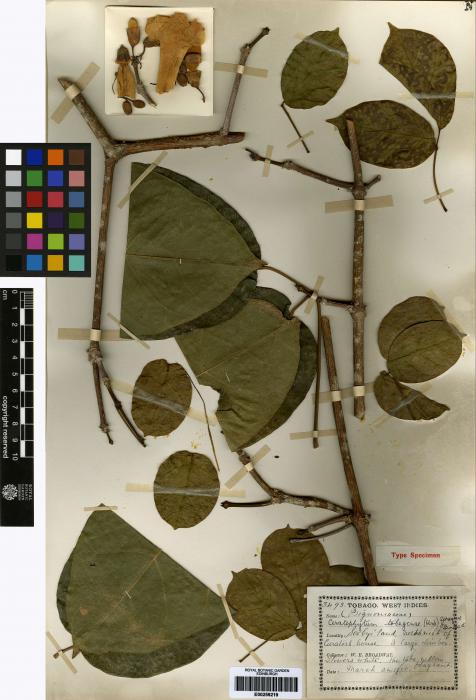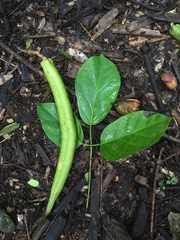
Neotropical Flora
|
Family: Bignoniaceae
|
C. tobagense (Urban) Sprague & Sandw. Liana; stems terete, striate, with prominent elongated lenticels and conspicuous interpetiolar glandular fields; tendrils trifid; pseudostipules at first small, +/- triangular, acuminate, paired, diverging in age to expose a third pseudostipule to 8 mm long. Leaves 3-foliolate, or 2-foliolate with a terminal tendril; petioles 3-12 cm long; terminal petiolules 2.1-4.6 cm long, the lateral petiolules 0.3-5.7 cm long; leaflets ovate, ovate-elliptic, oblong-ovate, or rarely obovate, usually abruptly acuminate, usually round to subcordate at base, 6-20 cm long, 4-15 cm wide, weakly coriaceous, domatia in axils of lateral veins cavelike, sometimes barbate at mouth. Panicles terminal, subcorymbose; calyx truncate, 10-13 mm long, coriaceous, glandular-lepidote, with fields of sunken glands in distal half; corolla white, becoming yellowish in age, densely pubescent outside and on lobes inside with moniliform trichomes, the tube yellow and glabrous inside, abruptly narrowed just above base, strongly 2-sulcate on 3-lobed side; stamens included, the longer pair 2.2-2.4 cm long, slightly shorter than style, set among a dense ring of trichomes near base; anther thecae divaricate, 4.5-6 mm long; pistil 3.2-3.3 cm long; ovary narrowly cylindrical, 5 mm long, lepidote. Capsules cylindrical, thick, elongated, acute at apex, blunt at base, 25-39 cm long, 3-4 cm wide, 2-2.5 cm thick, tan at maturity, densely covered with minute rounded or +/- elongated pits; seeds to 1.5 (1.8) cm long and 4.5 (6.3) cm wide. Croat 14458. Occasional, in the forest canopy; few fertile collections have been made on the island, Flowers at least in April, June, and October; individuals produce a few flowers over a long period, The fruits probably mature in the middle of the dry season, May be recognized in sterile condition by the woody, trilobate pseudostipules, the prominent interpetiolar glands, the trifid tendrils, and the axillary domatia on the leaflets. |
Powered by Symbiota.









